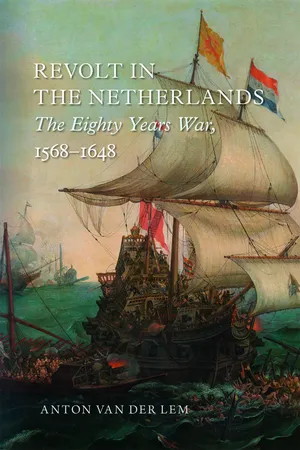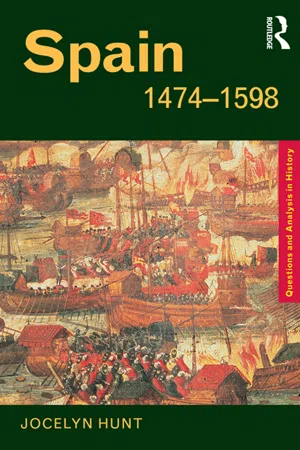History
Philip II of Spain
Philip II of Spain, also known as Philip the Prudent, was a powerful ruler during the 16th century. He expanded the Spanish Empire, strengthened Catholicism, and was a key figure in the Counter-Reformation. His reign was marked by conflicts with Protestant powers, including England, and he faced economic challenges due to costly military campaigns.
Written by Perlego with AI-assistance
Related key terms
3 Key excerpts on "Philip II of Spain"
- eBook - ePub
Lending to the Borrower from Hell
Debt, Taxes, and Default in the Age of Philip II
- Mauricio Drelichman, Hans-Joachim Voth(Authors)
- 2014(Publication Date)
- Princeton University Press(Publisher)
In late 1555, an increasingly frail and downcast Charles V finalized plans to divest his possessions. The Austrian domains passed on to his brother Ferdinand, who was also in line to succeed Charles as Holy Roman emperor. To Philip, Charles left the Iberian kingdoms and their colonies, the Low Countries, Sicily, Naples, and Milan—territories that, together, became known as the Spanish Empire.Charles V viewed himself as a medieval warrior leading his troops into battle. Titian’s famous portrait of him following his victory in the Battle of Mühlberg shows the emperor in shining armor, lance in hand, riding an enormous black horse. Philip II, in contrast, was a consummate administrator. He preferred the study to the battlefield, working his way through thousands of documents, many of which he annotated in his own hand. He micromanaged the affairs of government, and dealt with his officials, stakeholders, and sources of political and economic support on a day-to-day basis.30 Philip was fond of absorbing all aspects of an issue, soliciting and carefully weighing many different opinions before finally reaching a decision. This detail-oriented approach to decision making earned him the moniker “the prudent king.” His portrait—also by Titian—depicts him inside a palace, standing in front of a desk, and not in the fray of battle.Philip had been thoroughly groomed for his position, immersing himself in international affairs and administrative practices during his long education abroad. He was intimately acquainted with matters of government, having served as coregent of the Spanish kingdoms since 1551. While less keen on the personal warrior role than his father, he engaged in almost-constant warfare. Immediately after ascending to the throne, he was forced to confront Henry II of France, who attempted to seize the Habsburgs’ Italian possessions. Philip’s forces won decisive victories at Saint-Quentin in 1557 and Gravelines in 1558. While Philip could have marched on Paris, he did not do so because funding for the war’s continuation was uncertain. The treaty of Cateau-Cambrésis in 1559 put an end to the Italian wars, restoring the territorial balance that had existed before the hostilities. This reflected the financial exhaustion of both adversaries. The peace was sealed with Philip’s marriage to Henry’s daughter, Isabel of Valois. Known in Spain as Isabel of the Peace, she was Philip’s third wife, after Maria Manuela of Portugal and Mary I of England. - eBook - ePub
Revolt in the Netherlands
The Eighty Years War, 1568-1648
- Anton van Der Lem(Author)
- 2019(Publication Date)
- Reaktion Books(Publisher)
c. 1600. Around Philip’s neck is the medallion of the Order of the Golden Fleece. The Latin inscription reads ‘Philip, King of the English, Prince of the Spanish’. The image therefore dates from before his acceptance of rule of the Netherlands.During the years that Philip was in the Netherlands, Brussels functioned as the capital of his empire. That meant that he had an international entourage around him, with international advisers. Consequently, he had little or no time to fulfil his obligations in the governing institutions of the Netherlands. Although he was therefore himself present, immediately after his investiture he appointed a governor-general to deputize for him: Emmanuel Philibert, Duke of Savoy, whose duchy was occupied by France.19 This enabled Philip to concentrate on international politics. In 1555 an Italian cardinal was chosen as the new pope. Paul IV was not favourably inclined towards Spain and the Spanish, and in 1556 he declared war on Philip in Italy. Philip II charged the Duke of Alba with defending the Spanish crown’s possessions in Italy. His orders were not to spare Paul IV personally, but to treat the pope, as head of the Roman Catholic Church and the Holy See, with all due respect. Alba fulfilled this delicate mission with great success.20 His pacification of Italy was sufficient to spare the country from war for half a century.Philip’s major headache in foreign policy was the war with France. He felt that France could best be fought from the Low Countries.21 In July 1556 the war escalated again and Philip thought it high time to visit his wife, Mary, in England. He stayed in the country for the second – and last – time from the end of March to July 1557, where he successfully persuaded the English that their interests were also under threat. On 1 June 1557, Mary signed a declaration of war with France.22 Philip wanted to fight the French with English troops that same year and ordered Emmanuel Philibert, who was the commander of his armies in the Low Countries, to wait with the deciding battle until he arrived with his English reinforcements. He intended to lead his troops into battle himself for the first time and prove himself as their supreme commander. But the moment was too favourable for the Duke of Savoy to miss, and on 10 August he won a decisive victory over the French at Saint-Quentin. This victory was, to a large extent, thanks to the Count of Egmont, who led the cavalry and for whom the road to Paris now lay open. Philip arrived just in time to inspect the victorious troops.23 He dared not risk the road to Paris, leading instead the siege and capture of Saint-Quentin. This is the only time in Philip’s life that we see him so close to the field of battle. According to all reports, he was in his element.24 From then on, he would lead all wars and sieges from the study rooms in his palaces. A year later, in 1558, Egmont defeated the French decisively for a second time, this time at Gravelines, just to the south of Dunkirk.25 - eBook - ePub
- Jocelyn Hunt(Author)
- 2015(Publication Date)
- Routledge(Publisher)
creoles, the families of Spanish blood.The constant war against the Ottoman Turks can be seen as a religious crusade. On the other hand, the security of the Mediterranean continued to be crucial to Philip, as it had been to his predecessors. Throughout his reign, therefore, Philip sought to preserve the shipping lanes between Spain and Naples, and to protect the grain and other ships of the western Mediterranean against the North African pirates and their Turkish overlord. Although the great naval victory at Lepanto in 1571 reduced the danger of a Turkish attack, it did not eliminate it, and Philip was compelled always to have troops and ships available in the Mediterranean.In the rest of Europe, too, the requirements of religion often overlapped with the needs of other policy, and were on occasion completely irrelevant to Philip’s endeavours. The taking of Portugal was a matter of dynastic ambition rather than of religion. When Philip’s nephew Sebastian died in battle in North Africa in 1578, the throne of Portugal was disputed. Sebastian’s uncle Henry, a Cardinal, claimed the throne and immediately tried to persuade the Pope to release him from his vows so that he could produce an heir. But he was already an old man, and was challenged by Anthony, Prior of Crato, the son of Henry’s elder brother Luis. The problem was that Anthony was illegitimate, and the resulting uncertainty provided Philip with the opportunity to claim Portugal for his own. In 1580, with the death of Henry, Philip seized the throne. The Portuguese Cortes argued in vain that the female line (through which Philip claimed) was invalid in Portugal. Many powerful nobles, such as the Duke of Albuquerque, supported the Spanish claim, and Anthony, who had rashly sought refuge in Castile with his ‘proofs of legitimacy’ when his Uncle Henry had rejected his claim, had no choice but to escape. The defeat, in 1582, of Prince Anthony’s fleet at the Azores, despite the fact that some English ships were in support, followed by the recapture of the island of Terceira in 1583, established Philip securely on the throne of Portugal.
Learn about this page
Index pages curate the most relevant extracts from our library of academic textbooks. They’ve been created using an in-house natural language model (NLM), each adding context and meaning to key research topics.


